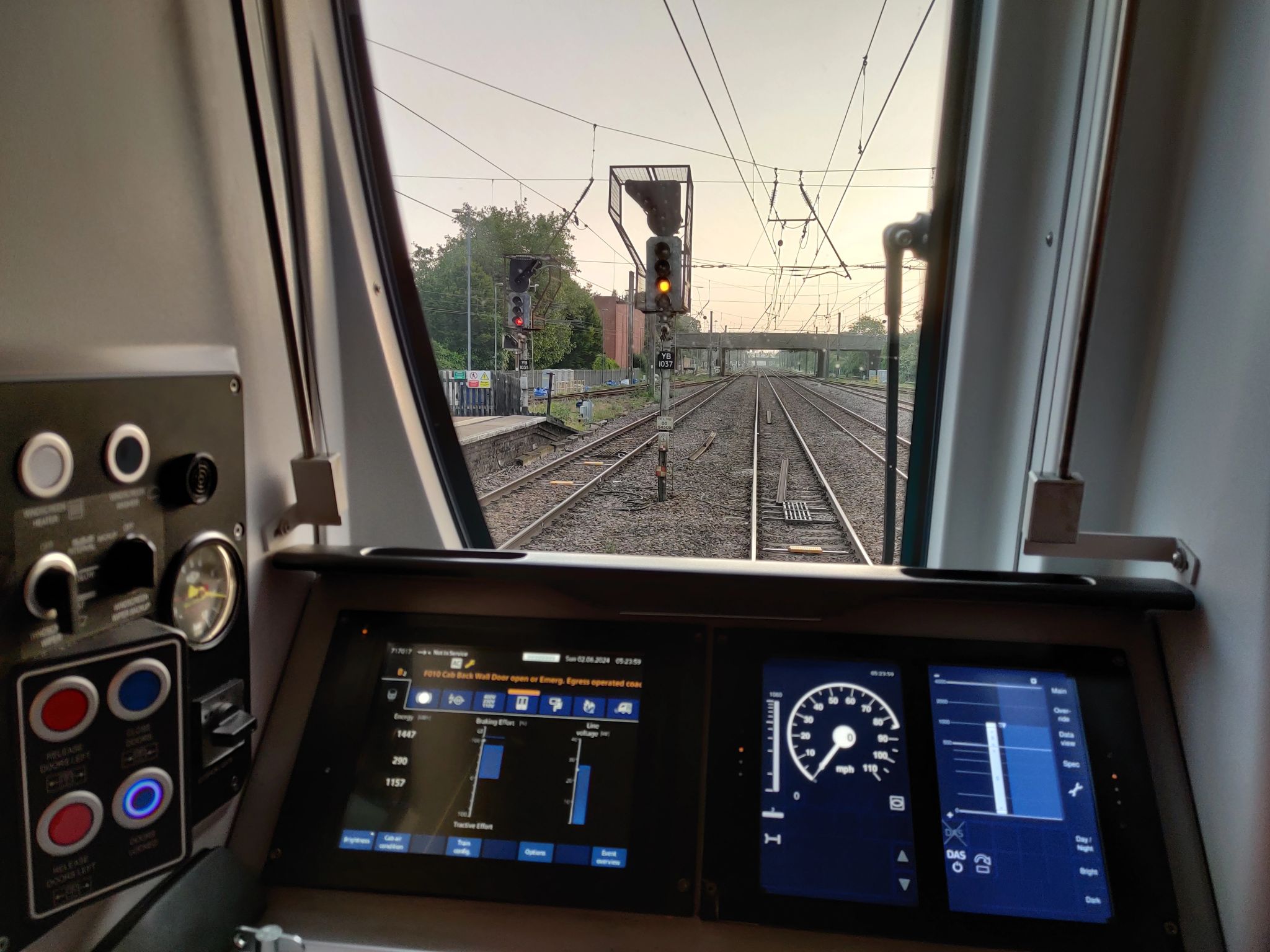
Ben Jones discovers how Network Rail is working with a cross-industry partnership to deliver a rolling programme of renewals that will transform how our trains are controlled.

Ben Jones discovers how Network Rail is working with a cross-industry partnership to deliver a rolling programme of renewals that will transform how our trains are controlled.
June 2 was a quietly significant day for British railways. A Great Northern Class 717 electric multiple unit (EMU) became the first train to operate under European Train Control System (ETCS) Level 2 in-cab signalling on the East Coast Main Line - a significant milestone in a programme that over the next two decades will revolutionise how our trains are controlled and protected.
The test run between Welwyn Garden City and Hitchin was the first live demonstration of the signalling system on the ECML, and is intended to help prove the compatibility of on-board equipment with new lineside infrastructure.
Perhaps even more significantly, on August 25 a Grand Central Class 180 diesel multiple unit and Network Rail’s New Measurement Train HST will become the first British trains to run at up to 125mph under ETCS supervision - a huge step towards the transformation of main line operation.
Testing will continue between Welwyn and Hitchin until mid-2025, with revenue-earning passenger and freight trains expected to follow shortly afterwards.
ETCS is already in daily use on the Northern City Line (NCL) between Drayton Park and Moorgate, with more than 50% of trains now supervised by the system.
Conversion to full ETCS operation is expected by early 2025, but expanding its reach onto one of the country’s busiest mixed-use main lines presents Network Rail and its partners with a much greater challenge.
Conversion
Over the next four years, the £1.4 billion East Coast Digital Programme (ECDP) will require the training of more than 3,000 drivers and thousands more support and engineering staff, as well as the conversion of more than 700 vehicles of 40 types with six different onboard ETCS systems supplied by Alstom, Hitachi, Siemens and CAF.
While some of these will be large fleets such as LNER’s Class 80X ‘Azumas’, Thameslink Class 700s and Class 66 freight diesels, others will be small quantities or even unique fitments such as heritage steam and diesel traction.
Preparing drivers across the country to use the new Driver-Machine Interfaces (DMIs) will be particularly important for the freight sector, as its locomotives travel much more widely than route-specific passenger stock.
More than 30 separate organisations are involved in ECDP, encompassing the entire industry - from Network Rail and train operators to the supply chain, rolling stock owners, engineering contractors, safety bodies, government, and trades unions.
Ed Akers, Industry Partnership Director for ECDP, explains: “This programme has a national importance - more than 60% of the current investment is nationally significant. We’re developing processes and systems that will be rolled out elsewhere and getting the supply chain and operators ready for the change.”
Toufic Machnouk, Network Rail Programme Director for ECDP adds: “Railways are fundamentally a friction reduction system, but current signalling systems are artificially constrained, and costs are high.
“Controlling straight to the cab is a ‘no brainer’, and all new railways are built this way. For legacy railways, the big questions are: ‘how do we make the transition’ and ‘is the pain worth it’?
“Signalling is at the heart of the railway. Changing it affects everything else and requires a strategic long-term view and a very different regulatory approach. But the benefits include a 42% reduction in signalling unit costs, 46% less track access to install the equipment, a 39% reduction in embodied carbon, and up to 33% improvement in capability and performance over traditional signalling.”
These savings are possible thanks to the elimination of lineside infrastructure such as heavy armoured cabling and its associated concrete or steel troughing, fixed signals and their concrete bases, and relay cabinets.
“Even taking into account the upfront costs of fitting ETCS equipment to vehicles, the overall cost is still 10%-20% cheaper than our current methods. And it delivers a more capable, more reliable, tighter tolerance railway,” says Machnouk.
Progress
ETCS equipment between Welwyn and Hitchin was successfully commissioned in February, and the proving process is now under way. Work to test the interaction between trains, equipment and York Railway Operating Centre (ROC) is taking place overnight or at weekends for the next two years.
Once the systems have cleared the testing, proving and approvals hurdles, migration to ETCS will begin in late 2025 and is expected to be complete in time for the fixed signals to be removed by late 2027.
The first section to transition directly to ‘no signals’ is likely to be Biggleswade-Fletton (south of Peterborough) in late 2027, with the entire route between King’s Cross and Stoke Tunnel (south of Grantham) complete by 2030.
Interestingly, East Midlands Railway is not part of the ECDP plan, meaning that EMR trains around Doncaster and on the ECML between Grantham and Peterborough will require a conventional signalling ‘overlay’ so that they can continue to operate.
NR’s Rail Innovation & Development Centre (RIDC) near Melton Mowbray is crucial to the ‘First of a Kind’ (FOAK) testing and approvals on locomotives and multiple units.
So far, a Grand Central Class 180, NR’s New Measurement Train and DB Cargo UK’s 66039 have received ETCS equipment. A DB Cargo Class 67 modified by Wabtec is due at RIDC for testing in November, while design work for the Direct Rail Services Class 88 electro-diesel is complete. Freightliner’s 66591 is the first locomotive to be upgraded to ETCS by its operator.
Akers says: “Approving freight operators to fit the equipment will make the rollout less painful and more efficient. We’re making significant progress on freight, but it’s a big challenge. Even a ‘standard’ Class 66 has at least four variants.”
Govia Thameslink Railway ‘Electrostar’ 387101 is the first of this widely used EMU design with ETCS, and it was back at RIDC for further testing in July and August. Meanwhile, contracts are in place for the installation of on-train equipment on the Thameslink Class 700 and LNER Class 80X fleets.
The first ‘Azuma’ is expected at RIDC in September. Its approval will be key to unlocking ETCS upgrades for the huge family of Hitachi Class 8XX trains used by LNER, Lumo, Hull Trains, TransPennine Express, Great Western Railway and Avanti West Coast.
The installation of ETCS equipment on heritage vehicles, allowing them to continue operation on the main line beyond the late 2020s, offers a very different set of challenges as every vehicle has to have its own safety case.
Peppercorn ‘A1’ 4-6-2 No. 60163 Tornado is now at the static testing phase after its recent major overhaul, representing a pioneering blend of steam power and digital technology.
Modifications to Locomotive Services Limited’s ‘Deltic’ D9000 Royal Scots Grey are also progressing well, while other older diesel types to be considered for conversion include Classes 37, ‘47’, ‘56’ and ‘69’. Class 20s have not been included as they no longer cover the mileage required to make them a priority.
Transition
NR’s long-term transition started back in 2007-11, with a pilot phase that featured an older version of ETCS installed on the Cambrian Coast Line in Wales. This provided valuable lessons and operational experience which have been applied to the current ‘Pathfinder’ phase as part of ECDP.
As the current four-year phase draws to a close with trial ETCS operation on the ECML, the ECDP team is gearing up for its biggest challenge - the ‘Pioneer’ phase.
“The Pioneer phase is our biggest leap,” says Machnouk.
“We’ve got to ‘walk the walk’ with every operator and more than 30 industry partners. Among its many objectives are the need to build system capabilities and develop a broader supply chain so that we can build the capability for multiple route deployment beyond 2028.
“We don’t make any decisions until route, operators and suppliers agree a delivery model and phases. At the moment, system proving needs more creativity, approvals take too long and are too complex, and train modifications are awkward - we must find ways to make them easier. Driver training also needs to evolve.”
All this will need to be in place by the time ECDP is complete and the ‘Pioneer’ phase ends in 2028. Meanwhile, preparations for wider deployment are already under way as part of the overlapping ‘Portfolio’ phase which runs for the next decade.
NR’s targets after the completion of ECDP in the late 2020s are the Transpennine Route Upgrade (TRU) between York and Manchester, the Warrington-Carlisle section of the West Coast Main Line, the Midland Main Line and the Brighton Main Line.
All these schemes will overlap in a ten-year phase from Control Period 7 (CP7, 2024-29), unlocking between one-third and one-half of the network with an emphasis on routes in northern England.
“It has to be done as a broad partnership. It can’t work any other way,” continues Akers.
“Engineers and operators are working together to design systems. Our approach is that no one gets left behind. OEMs [original equipment manufacturers] are part of the process, as they will need to move fast to manage updates and improvements.
“Industry integration is the biggest challenge - our approach is unique in the industry and a foretaste of what could happen under Great British Railways (GBR).
“A lot of signalling investment for CP7 and CP8 is driven by life extensions. It’s not as simple as renewing everything with ETCS, due to constraints in market and supply chain capacity. But the first areas we do will drive the capability to other renewals as capacity and capability grows.”
Machnouk concludes: “ETCS is not static. It will continue to evolve with technology such as Future Rail Mobile Communication System [successor to the current GSM-R] and Automatic Train Operation (ATO).
“Thanks to Thameslink we’re ahead of the game on ATO, but there are lots of interesting tech developments to come, such as quantum navigation - developed from GPS - and operating systems.
“We are pushing the railway towards greater technical development, evolving every few years instead of fitting a relay room and coming back to replace it in 40 years.”
Login to continue reading
Or register with RAIL to keep up-to-date with the latest news, insight and opinion.


















Login to comment
Comments
No comments have been made yet.